Strategic Analysis of Qantas and Virgin Airlines: A Competitive Report
VerifiedAdded on 2020/05/16
|10
|1803
|147
Report
AI Summary
This report provides a comprehensive analysis of the competitive strategies employed by Qantas and Virgin Australia airlines. It begins with an executive summary and table of contents, then delves into the target markets and modes of entry for both airlines, including discussions on their market segmentation and strategies such as mergers, acquisitions, and joint ventures. The report examines the global branding strategies of each airline, highlighting key differentiators and branding elements. Furthermore, it explores the reasons behind the success and failure of both Qantas and Virgin, offering insights into their domestic and international market performance. The report concludes with an overview of the key findings, providing a comparative analysis of the two major Australian airlines and their approaches to competitive advantage. The report also includes references to support the analysis.
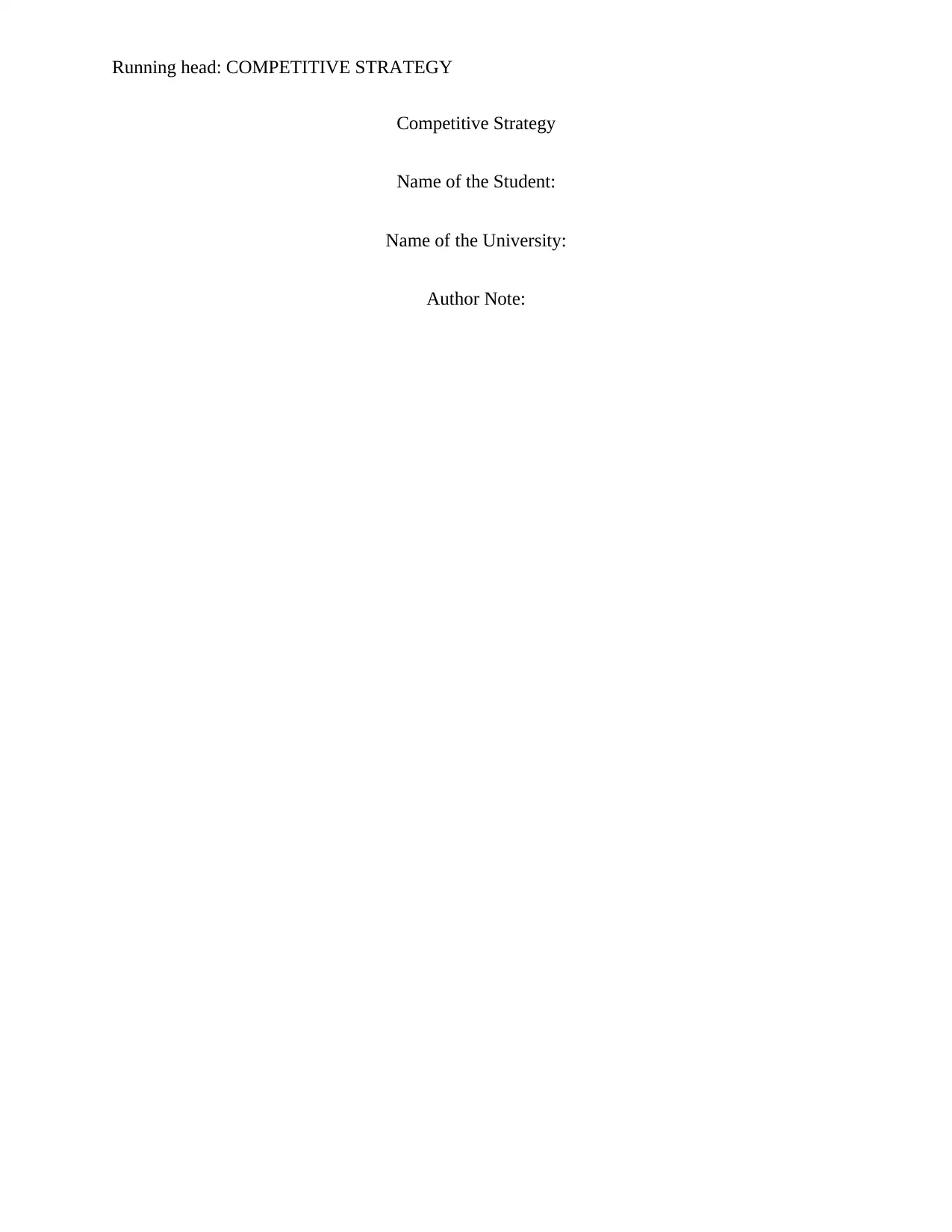
Running head: COMPETITIVE STRATEGY
Competitive Strategy
Name of the Student:
Name of the University:
Author Note:
Competitive Strategy
Name of the Student:
Name of the University:
Author Note:
Paraphrase This Document
Need a fresh take? Get an instant paraphrase of this document with our AI Paraphraser
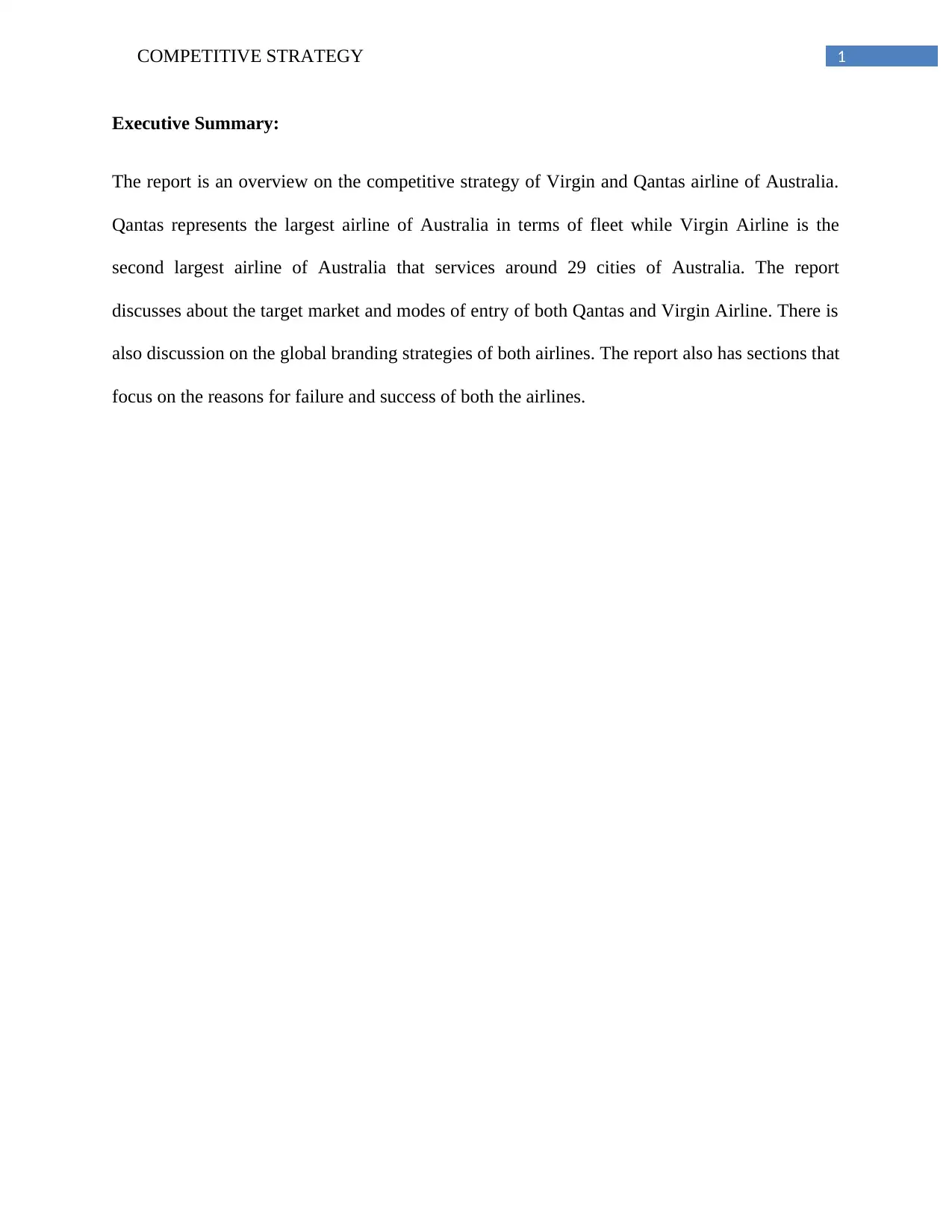
1COMPETITIVE STRATEGY
Executive Summary:
The report is an overview on the competitive strategy of Virgin and Qantas airline of Australia.
Qantas represents the largest airline of Australia in terms of fleet while Virgin Airline is the
second largest airline of Australia that services around 29 cities of Australia. The report
discusses about the target market and modes of entry of both Qantas and Virgin Airline. There is
also discussion on the global branding strategies of both airlines. The report also has sections that
focus on the reasons for failure and success of both the airlines.
Executive Summary:
The report is an overview on the competitive strategy of Virgin and Qantas airline of Australia.
Qantas represents the largest airline of Australia in terms of fleet while Virgin Airline is the
second largest airline of Australia that services around 29 cities of Australia. The report
discusses about the target market and modes of entry of both Qantas and Virgin Airline. There is
also discussion on the global branding strategies of both airlines. The report also has sections that
focus on the reasons for failure and success of both the airlines.
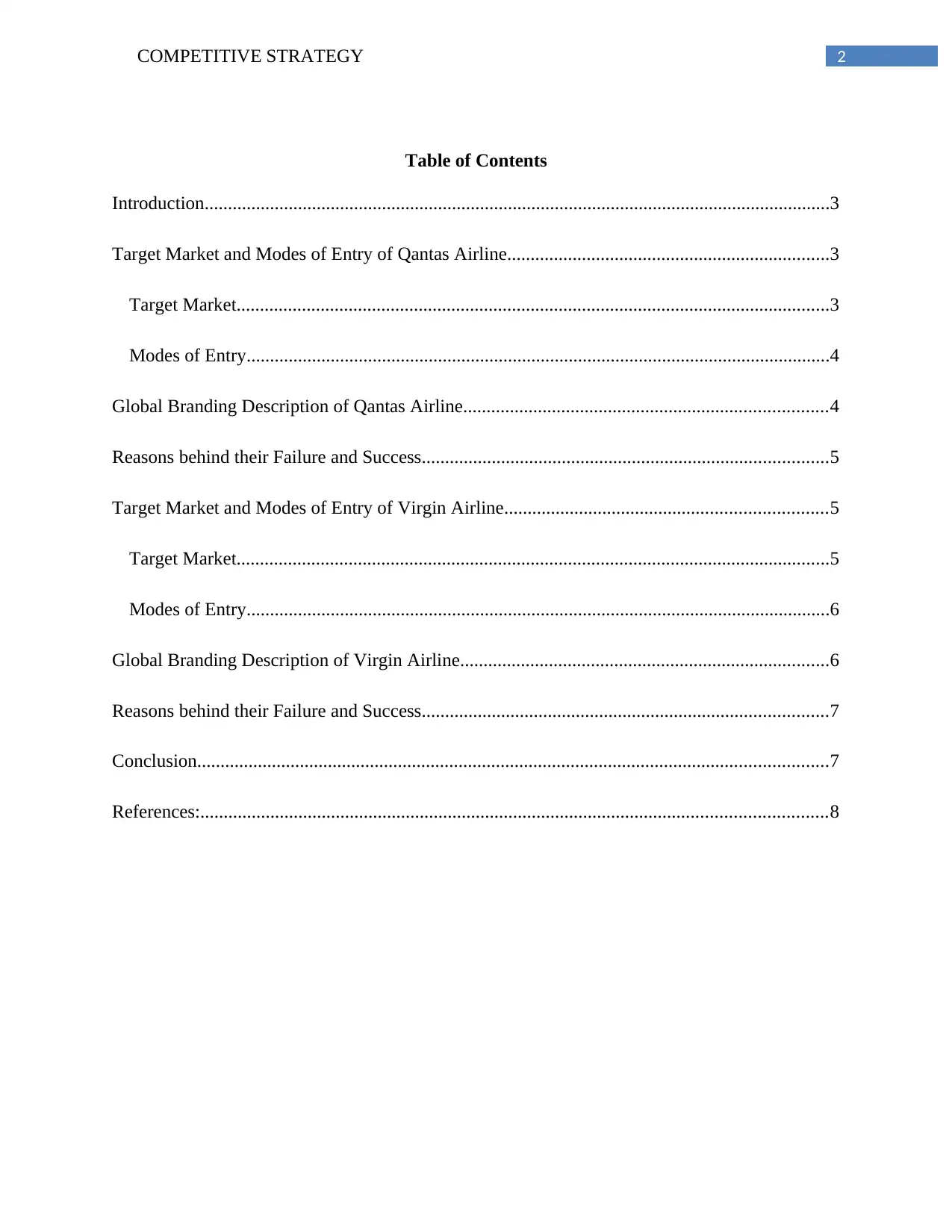
2COMPETITIVE STRATEGY
Table of Contents
Introduction......................................................................................................................................3
Target Market and Modes of Entry of Qantas Airline.....................................................................3
Target Market...............................................................................................................................3
Modes of Entry.............................................................................................................................4
Global Branding Description of Qantas Airline..............................................................................4
Reasons behind their Failure and Success.......................................................................................5
Target Market and Modes of Entry of Virgin Airline.....................................................................5
Target Market...............................................................................................................................5
Modes of Entry.............................................................................................................................6
Global Branding Description of Virgin Airline...............................................................................6
Reasons behind their Failure and Success.......................................................................................7
Conclusion.......................................................................................................................................7
References:......................................................................................................................................8
Table of Contents
Introduction......................................................................................................................................3
Target Market and Modes of Entry of Qantas Airline.....................................................................3
Target Market...............................................................................................................................3
Modes of Entry.............................................................................................................................4
Global Branding Description of Qantas Airline..............................................................................4
Reasons behind their Failure and Success.......................................................................................5
Target Market and Modes of Entry of Virgin Airline.....................................................................5
Target Market...............................................................................................................................5
Modes of Entry.............................................................................................................................6
Global Branding Description of Virgin Airline...............................................................................6
Reasons behind their Failure and Success.......................................................................................7
Conclusion.......................................................................................................................................7
References:......................................................................................................................................8
⊘ This is a preview!⊘
Do you want full access?
Subscribe today to unlock all pages.

Trusted by 1+ million students worldwide
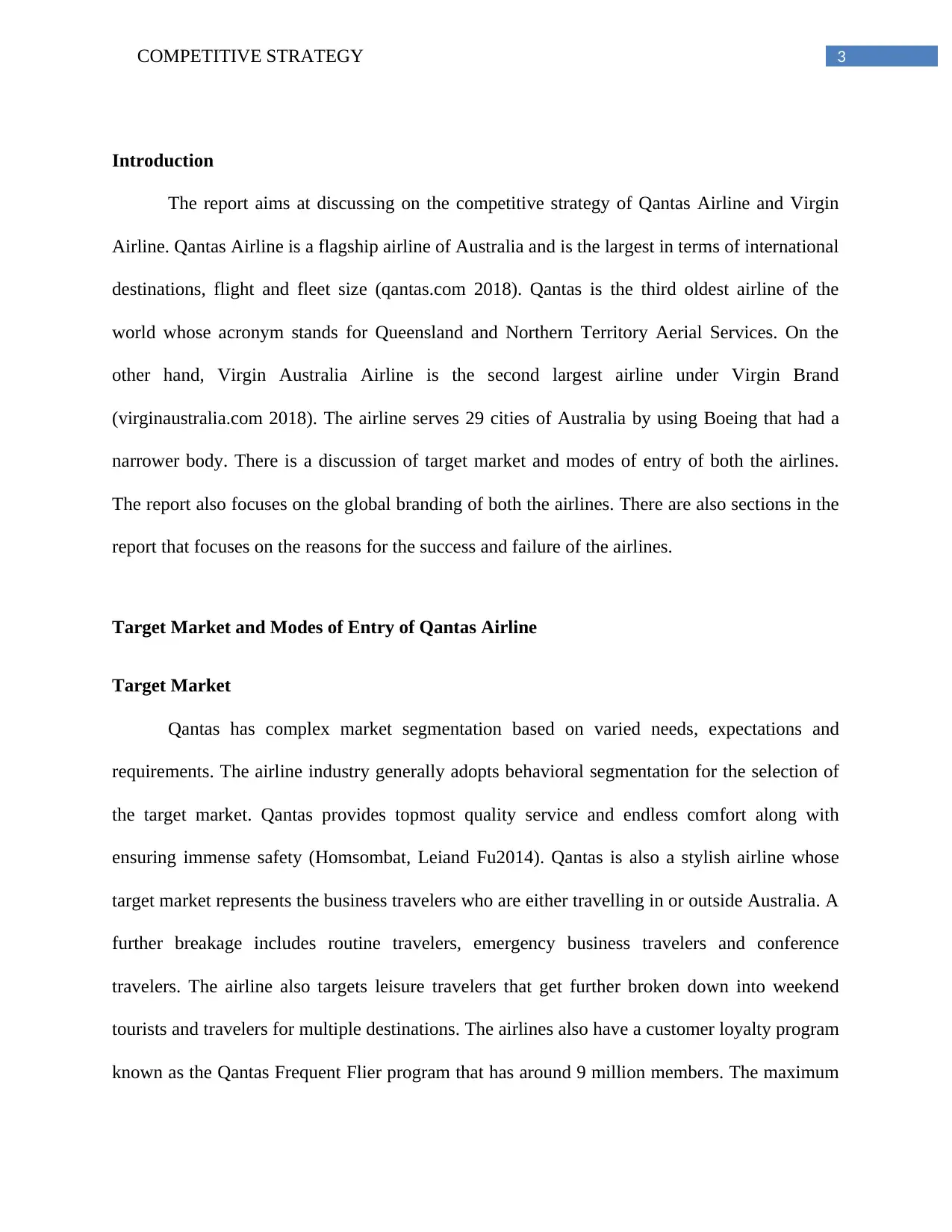
3COMPETITIVE STRATEGY
Introduction
The report aims at discussing on the competitive strategy of Qantas Airline and Virgin
Airline. Qantas Airline is a flagship airline of Australia and is the largest in terms of international
destinations, flight and fleet size (qantas.com 2018). Qantas is the third oldest airline of the
world whose acronym stands for Queensland and Northern Territory Aerial Services. On the
other hand, Virgin Australia Airline is the second largest airline under Virgin Brand
(virginaustralia.com 2018). The airline serves 29 cities of Australia by using Boeing that had a
narrower body. There is a discussion of target market and modes of entry of both the airlines.
The report also focuses on the global branding of both the airlines. There are also sections in the
report that focuses on the reasons for the success and failure of the airlines.
Target Market and Modes of Entry of Qantas Airline
Target Market
Qantas has complex market segmentation based on varied needs, expectations and
requirements. The airline industry generally adopts behavioral segmentation for the selection of
the target market. Qantas provides topmost quality service and endless comfort along with
ensuring immense safety (Homsombat, Leiand Fu2014). Qantas is also a stylish airline whose
target market represents the business travelers who are either travelling in or outside Australia. A
further breakage includes routine travelers, emergency business travelers and conference
travelers. The airline also targets leisure travelers that get further broken down into weekend
tourists and travelers for multiple destinations. The airlines also have a customer loyalty program
known as the Qantas Frequent Flier program that has around 9 million members. The maximum
Introduction
The report aims at discussing on the competitive strategy of Qantas Airline and Virgin
Airline. Qantas Airline is a flagship airline of Australia and is the largest in terms of international
destinations, flight and fleet size (qantas.com 2018). Qantas is the third oldest airline of the
world whose acronym stands for Queensland and Northern Territory Aerial Services. On the
other hand, Virgin Australia Airline is the second largest airline under Virgin Brand
(virginaustralia.com 2018). The airline serves 29 cities of Australia by using Boeing that had a
narrower body. There is a discussion of target market and modes of entry of both the airlines.
The report also focuses on the global branding of both the airlines. There are also sections in the
report that focuses on the reasons for the success and failure of the airlines.
Target Market and Modes of Entry of Qantas Airline
Target Market
Qantas has complex market segmentation based on varied needs, expectations and
requirements. The airline industry generally adopts behavioral segmentation for the selection of
the target market. Qantas provides topmost quality service and endless comfort along with
ensuring immense safety (Homsombat, Leiand Fu2014). Qantas is also a stylish airline whose
target market represents the business travelers who are either travelling in or outside Australia. A
further breakage includes routine travelers, emergency business travelers and conference
travelers. The airline also targets leisure travelers that get further broken down into weekend
tourists and travelers for multiple destinations. The airlines also have a customer loyalty program
known as the Qantas Frequent Flier program that has around 9 million members. The maximum
Paraphrase This Document
Need a fresh take? Get an instant paraphrase of this document with our AI Paraphraser
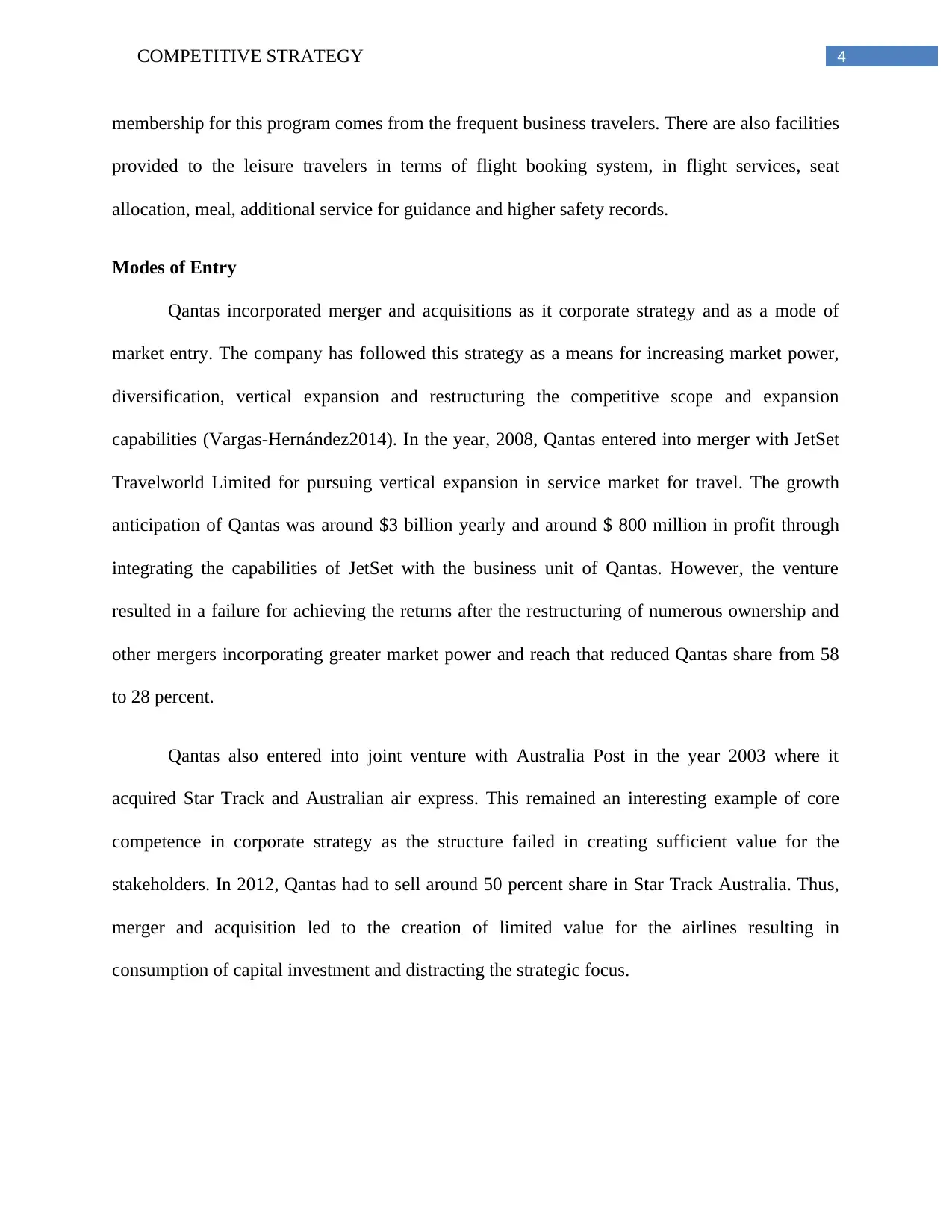
4COMPETITIVE STRATEGY
membership for this program comes from the frequent business travelers. There are also facilities
provided to the leisure travelers in terms of flight booking system, in flight services, seat
allocation, meal, additional service for guidance and higher safety records.
Modes of Entry
Qantas incorporated merger and acquisitions as it corporate strategy and as a mode of
market entry. The company has followed this strategy as a means for increasing market power,
diversification, vertical expansion and restructuring the competitive scope and expansion
capabilities (Vargas-Hernández2014). In the year, 2008, Qantas entered into merger with JetSet
Travelworld Limited for pursuing vertical expansion in service market for travel. The growth
anticipation of Qantas was around $3 billion yearly and around $ 800 million in profit through
integrating the capabilities of JetSet with the business unit of Qantas. However, the venture
resulted in a failure for achieving the returns after the restructuring of numerous ownership and
other mergers incorporating greater market power and reach that reduced Qantas share from 58
to 28 percent.
Qantas also entered into joint venture with Australia Post in the year 2003 where it
acquired Star Track and Australian air express. This remained an interesting example of core
competence in corporate strategy as the structure failed in creating sufficient value for the
stakeholders. In 2012, Qantas had to sell around 50 percent share in Star Track Australia. Thus,
merger and acquisition led to the creation of limited value for the airlines resulting in
consumption of capital investment and distracting the strategic focus.
membership for this program comes from the frequent business travelers. There are also facilities
provided to the leisure travelers in terms of flight booking system, in flight services, seat
allocation, meal, additional service for guidance and higher safety records.
Modes of Entry
Qantas incorporated merger and acquisitions as it corporate strategy and as a mode of
market entry. The company has followed this strategy as a means for increasing market power,
diversification, vertical expansion and restructuring the competitive scope and expansion
capabilities (Vargas-Hernández2014). In the year, 2008, Qantas entered into merger with JetSet
Travelworld Limited for pursuing vertical expansion in service market for travel. The growth
anticipation of Qantas was around $3 billion yearly and around $ 800 million in profit through
integrating the capabilities of JetSet with the business unit of Qantas. However, the venture
resulted in a failure for achieving the returns after the restructuring of numerous ownership and
other mergers incorporating greater market power and reach that reduced Qantas share from 58
to 28 percent.
Qantas also entered into joint venture with Australia Post in the year 2003 where it
acquired Star Track and Australian air express. This remained an interesting example of core
competence in corporate strategy as the structure failed in creating sufficient value for the
stakeholders. In 2012, Qantas had to sell around 50 percent share in Star Track Australia. Thus,
merger and acquisition led to the creation of limited value for the airlines resulting in
consumption of capital investment and distracting the strategic focus.
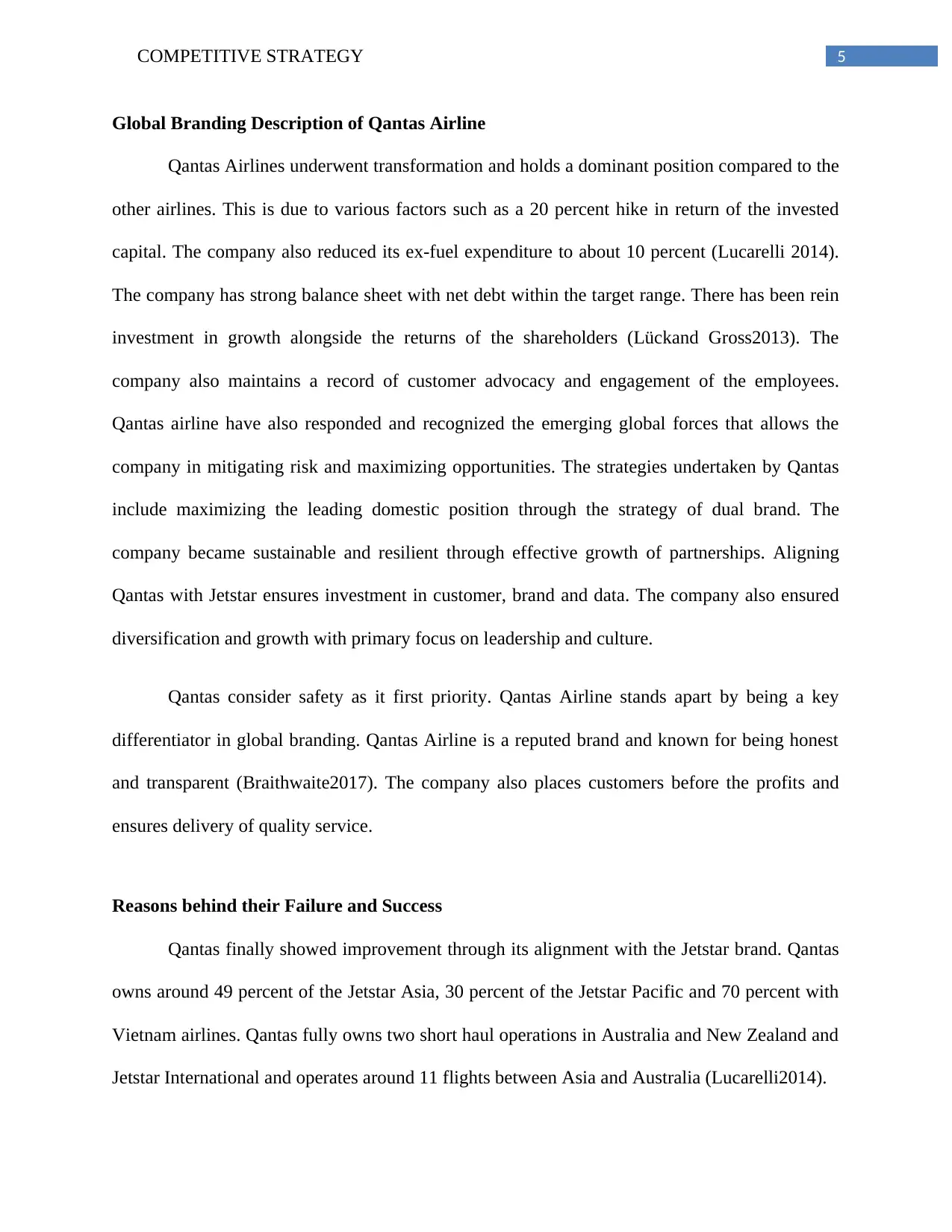
5COMPETITIVE STRATEGY
Global Branding Description of Qantas Airline
Qantas Airlines underwent transformation and holds a dominant position compared to the
other airlines. This is due to various factors such as a 20 percent hike in return of the invested
capital. The company also reduced its ex-fuel expenditure to about 10 percent (Lucarelli 2014).
The company has strong balance sheet with net debt within the target range. There has been rein
investment in growth alongside the returns of the shareholders (Lückand Gross2013). The
company also maintains a record of customer advocacy and engagement of the employees.
Qantas airline have also responded and recognized the emerging global forces that allows the
company in mitigating risk and maximizing opportunities. The strategies undertaken by Qantas
include maximizing the leading domestic position through the strategy of dual brand. The
company became sustainable and resilient through effective growth of partnerships. Aligning
Qantas with Jetstar ensures investment in customer, brand and data. The company also ensured
diversification and growth with primary focus on leadership and culture.
Qantas consider safety as it first priority. Qantas Airline stands apart by being a key
differentiator in global branding. Qantas Airline is a reputed brand and known for being honest
and transparent (Braithwaite2017). The company also places customers before the profits and
ensures delivery of quality service.
Reasons behind their Failure and Success
Qantas finally showed improvement through its alignment with the Jetstar brand. Qantas
owns around 49 percent of the Jetstar Asia, 30 percent of the Jetstar Pacific and 70 percent with
Vietnam airlines. Qantas fully owns two short haul operations in Australia and New Zealand and
Jetstar International and operates around 11 flights between Asia and Australia (Lucarelli2014).
Global Branding Description of Qantas Airline
Qantas Airlines underwent transformation and holds a dominant position compared to the
other airlines. This is due to various factors such as a 20 percent hike in return of the invested
capital. The company also reduced its ex-fuel expenditure to about 10 percent (Lucarelli 2014).
The company has strong balance sheet with net debt within the target range. There has been rein
investment in growth alongside the returns of the shareholders (Lückand Gross2013). The
company also maintains a record of customer advocacy and engagement of the employees.
Qantas airline have also responded and recognized the emerging global forces that allows the
company in mitigating risk and maximizing opportunities. The strategies undertaken by Qantas
include maximizing the leading domestic position through the strategy of dual brand. The
company became sustainable and resilient through effective growth of partnerships. Aligning
Qantas with Jetstar ensures investment in customer, brand and data. The company also ensured
diversification and growth with primary focus on leadership and culture.
Qantas consider safety as it first priority. Qantas Airline stands apart by being a key
differentiator in global branding. Qantas Airline is a reputed brand and known for being honest
and transparent (Braithwaite2017). The company also places customers before the profits and
ensures delivery of quality service.
Reasons behind their Failure and Success
Qantas finally showed improvement through its alignment with the Jetstar brand. Qantas
owns around 49 percent of the Jetstar Asia, 30 percent of the Jetstar Pacific and 70 percent with
Vietnam airlines. Qantas fully owns two short haul operations in Australia and New Zealand and
Jetstar International and operates around 11 flights between Asia and Australia (Lucarelli2014).
⊘ This is a preview!⊘
Do you want full access?
Subscribe today to unlock all pages.

Trusted by 1+ million students worldwide
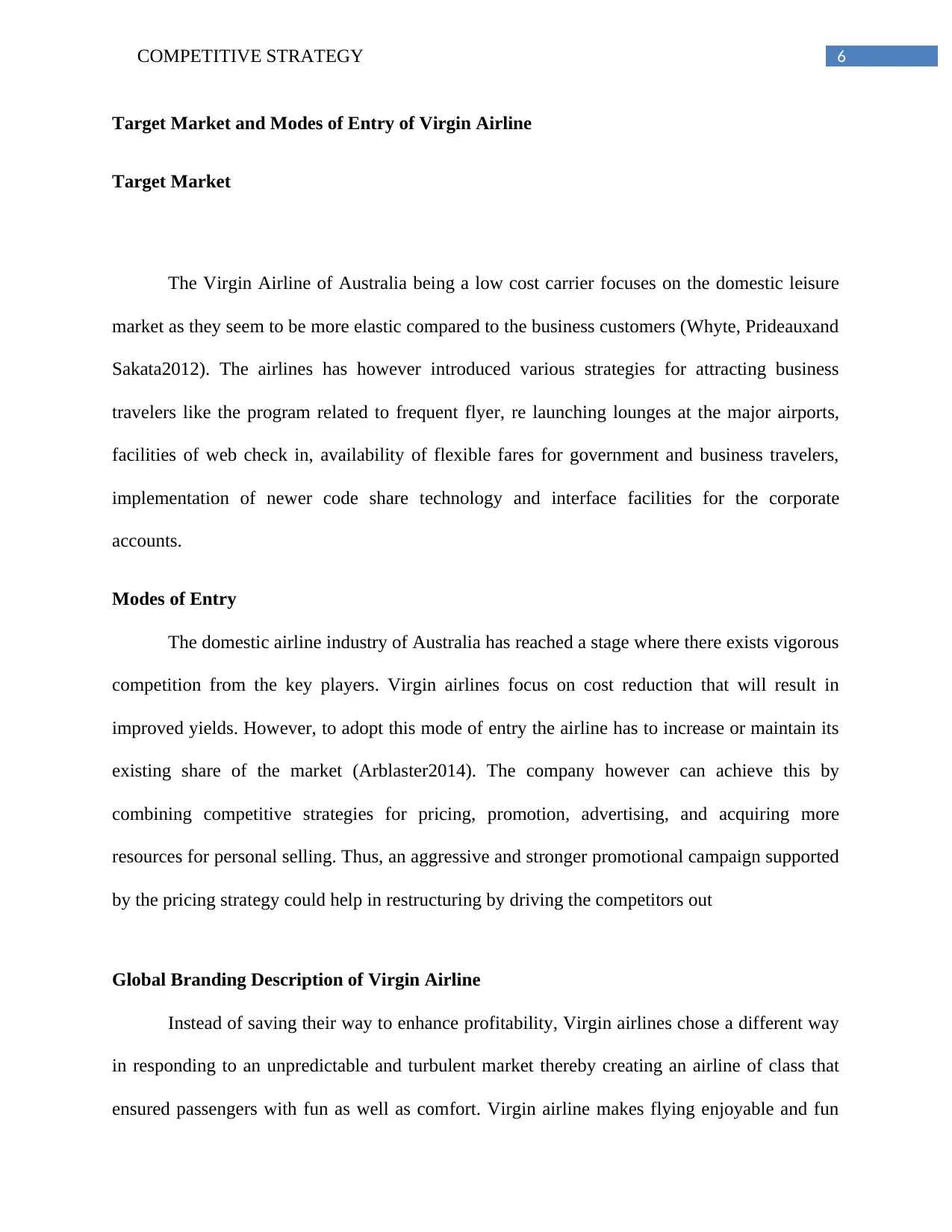
6COMPETITIVE STRATEGY
Target Market and Modes of Entry of Virgin Airline
Target Market
The Virgin Airline of Australia being a low cost carrier focuses on the domestic leisure
market as they seem to be more elastic compared to the business customers (Whyte, Prideauxand
Sakata2012). The airlines has however introduced various strategies for attracting business
travelers like the program related to frequent flyer, re launching lounges at the major airports,
facilities of web check in, availability of flexible fares for government and business travelers,
implementation of newer code share technology and interface facilities for the corporate
accounts.
Modes of Entry
The domestic airline industry of Australia has reached a stage where there exists vigorous
competition from the key players. Virgin airlines focus on cost reduction that will result in
improved yields. However, to adopt this mode of entry the airline has to increase or maintain its
existing share of the market (Arblaster2014). The company however can achieve this by
combining competitive strategies for pricing, promotion, advertising, and acquiring more
resources for personal selling. Thus, an aggressive and stronger promotional campaign supported
by the pricing strategy could help in restructuring by driving the competitors out
Global Branding Description of Virgin Airline
Instead of saving their way to enhance profitability, Virgin airlines chose a different way
in responding to an unpredictable and turbulent market thereby creating an airline of class that
ensured passengers with fun as well as comfort. Virgin airline makes flying enjoyable and fun
Target Market and Modes of Entry of Virgin Airline
Target Market
The Virgin Airline of Australia being a low cost carrier focuses on the domestic leisure
market as they seem to be more elastic compared to the business customers (Whyte, Prideauxand
Sakata2012). The airlines has however introduced various strategies for attracting business
travelers like the program related to frequent flyer, re launching lounges at the major airports,
facilities of web check in, availability of flexible fares for government and business travelers,
implementation of newer code share technology and interface facilities for the corporate
accounts.
Modes of Entry
The domestic airline industry of Australia has reached a stage where there exists vigorous
competition from the key players. Virgin airlines focus on cost reduction that will result in
improved yields. However, to adopt this mode of entry the airline has to increase or maintain its
existing share of the market (Arblaster2014). The company however can achieve this by
combining competitive strategies for pricing, promotion, advertising, and acquiring more
resources for personal selling. Thus, an aggressive and stronger promotional campaign supported
by the pricing strategy could help in restructuring by driving the competitors out
Global Branding Description of Virgin Airline
Instead of saving their way to enhance profitability, Virgin airlines chose a different way
in responding to an unpredictable and turbulent market thereby creating an airline of class that
ensured passengers with fun as well as comfort. Virgin airline makes flying enjoyable and fun
Paraphrase This Document
Need a fresh take? Get an instant paraphrase of this document with our AI Paraphraser
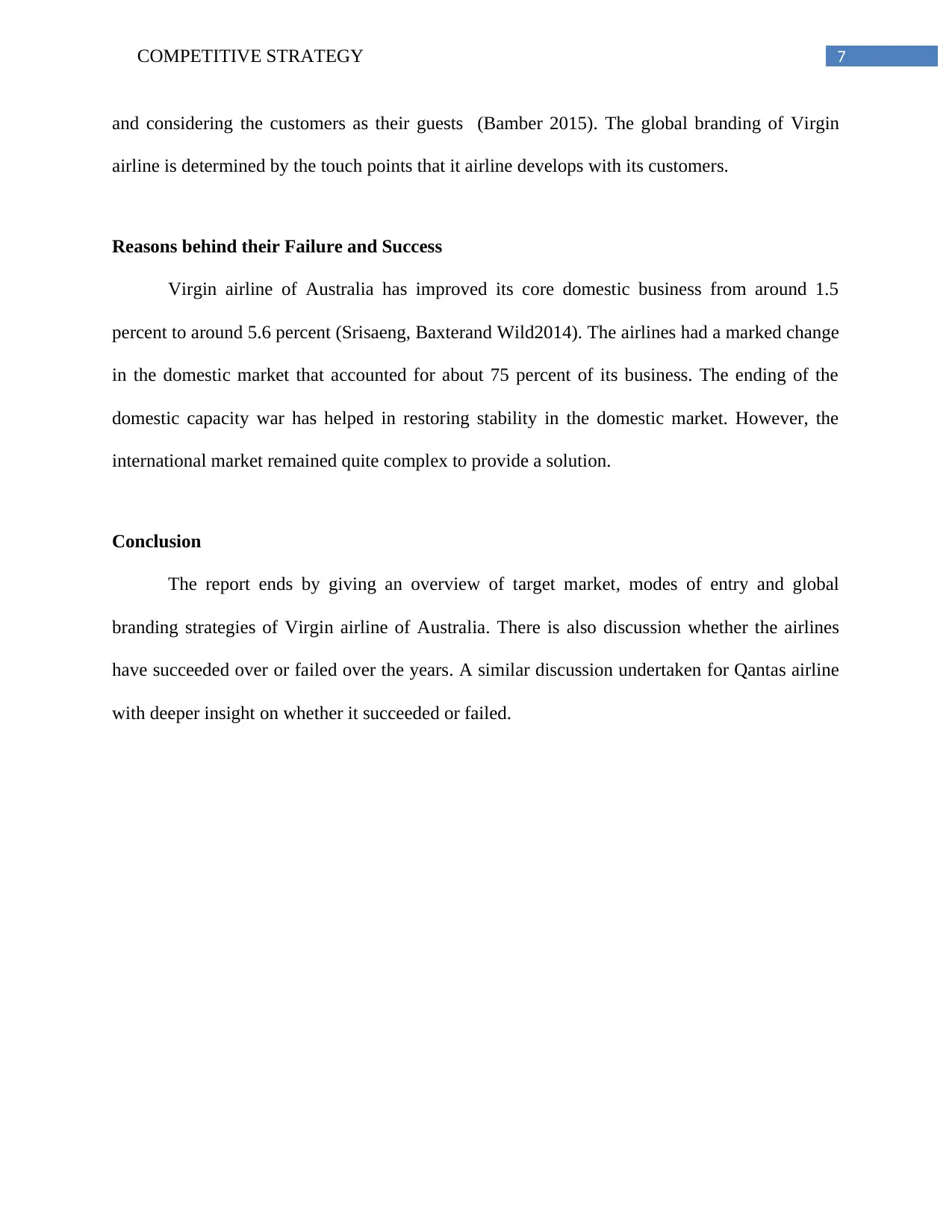
7COMPETITIVE STRATEGY
and considering the customers as their guests (Bamber 2015). The global branding of Virgin
airline is determined by the touch points that it airline develops with its customers.
Reasons behind their Failure and Success
Virgin airline of Australia has improved its core domestic business from around 1.5
percent to around 5.6 percent (Srisaeng, Baxterand Wild2014). The airlines had a marked change
in the domestic market that accounted for about 75 percent of its business. The ending of the
domestic capacity war has helped in restoring stability in the domestic market. However, the
international market remained quite complex to provide a solution.
Conclusion
The report ends by giving an overview of target market, modes of entry and global
branding strategies of Virgin airline of Australia. There is also discussion whether the airlines
have succeeded over or failed over the years. A similar discussion undertaken for Qantas airline
with deeper insight on whether it succeeded or failed.
and considering the customers as their guests (Bamber 2015). The global branding of Virgin
airline is determined by the touch points that it airline develops with its customers.
Reasons behind their Failure and Success
Virgin airline of Australia has improved its core domestic business from around 1.5
percent to around 5.6 percent (Srisaeng, Baxterand Wild2014). The airlines had a marked change
in the domestic market that accounted for about 75 percent of its business. The ending of the
domestic capacity war has helped in restoring stability in the domestic market. However, the
international market remained quite complex to provide a solution.
Conclusion
The report ends by giving an overview of target market, modes of entry and global
branding strategies of Virgin airline of Australia. There is also discussion whether the airlines
have succeeded over or failed over the years. A similar discussion undertaken for Qantas airline
with deeper insight on whether it succeeded or failed.
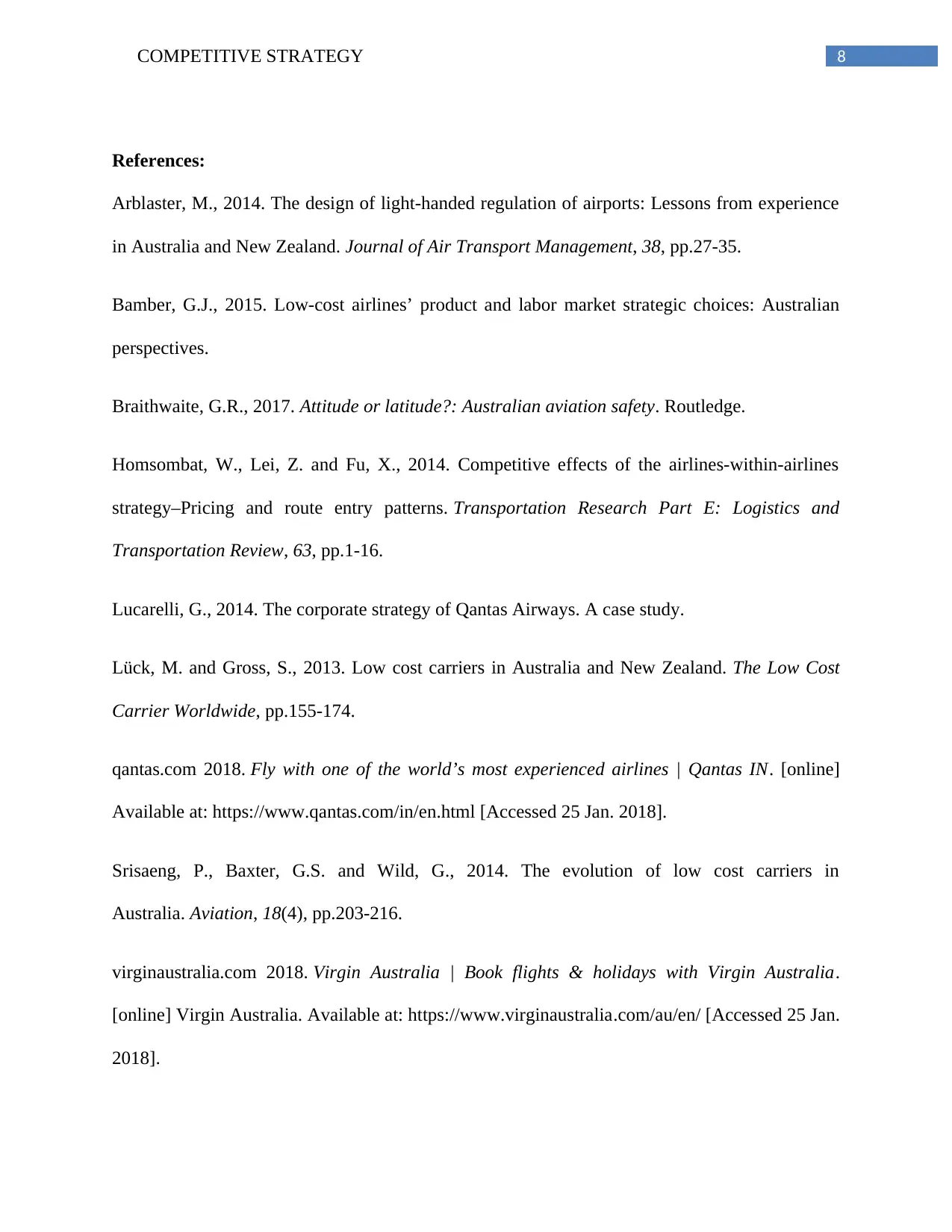
8COMPETITIVE STRATEGY
References:
Arblaster, M., 2014. The design of light-handed regulation of airports: Lessons from experience
in Australia and New Zealand. Journal of Air Transport Management, 38, pp.27-35.
Bamber, G.J., 2015. Low-cost airlines’ product and labor market strategic choices: Australian
perspectives.
Braithwaite, G.R., 2017. Attitude or latitude?: Australian aviation safety. Routledge.
Homsombat, W., Lei, Z. and Fu, X., 2014. Competitive effects of the airlines-within-airlines
strategy–Pricing and route entry patterns. Transportation Research Part E: Logistics and
Transportation Review, 63, pp.1-16.
Lucarelli, G., 2014. The corporate strategy of Qantas Airways. A case study.
Lück, M. and Gross, S., 2013. Low cost carriers in Australia and New Zealand. The Low Cost
Carrier Worldwide, pp.155-174.
qantas.com 2018. Fly with one of the world’s most experienced airlines | Qantas IN. [online]
Available at: https://www.qantas.com/in/en.html [Accessed 25 Jan. 2018].
Srisaeng, P., Baxter, G.S. and Wild, G., 2014. The evolution of low cost carriers in
Australia. Aviation, 18(4), pp.203-216.
virginaustralia.com 2018. Virgin Australia | Book flights & holidays with Virgin Australia.
[online] Virgin Australia. Available at: https://www.virginaustralia.com/au/en/ [Accessed 25 Jan.
2018].
References:
Arblaster, M., 2014. The design of light-handed regulation of airports: Lessons from experience
in Australia and New Zealand. Journal of Air Transport Management, 38, pp.27-35.
Bamber, G.J., 2015. Low-cost airlines’ product and labor market strategic choices: Australian
perspectives.
Braithwaite, G.R., 2017. Attitude or latitude?: Australian aviation safety. Routledge.
Homsombat, W., Lei, Z. and Fu, X., 2014. Competitive effects of the airlines-within-airlines
strategy–Pricing and route entry patterns. Transportation Research Part E: Logistics and
Transportation Review, 63, pp.1-16.
Lucarelli, G., 2014. The corporate strategy of Qantas Airways. A case study.
Lück, M. and Gross, S., 2013. Low cost carriers in Australia and New Zealand. The Low Cost
Carrier Worldwide, pp.155-174.
qantas.com 2018. Fly with one of the world’s most experienced airlines | Qantas IN. [online]
Available at: https://www.qantas.com/in/en.html [Accessed 25 Jan. 2018].
Srisaeng, P., Baxter, G.S. and Wild, G., 2014. The evolution of low cost carriers in
Australia. Aviation, 18(4), pp.203-216.
virginaustralia.com 2018. Virgin Australia | Book flights & holidays with Virgin Australia.
[online] Virgin Australia. Available at: https://www.virginaustralia.com/au/en/ [Accessed 25 Jan.
2018].
⊘ This is a preview!⊘
Do you want full access?
Subscribe today to unlock all pages.

Trusted by 1+ million students worldwide
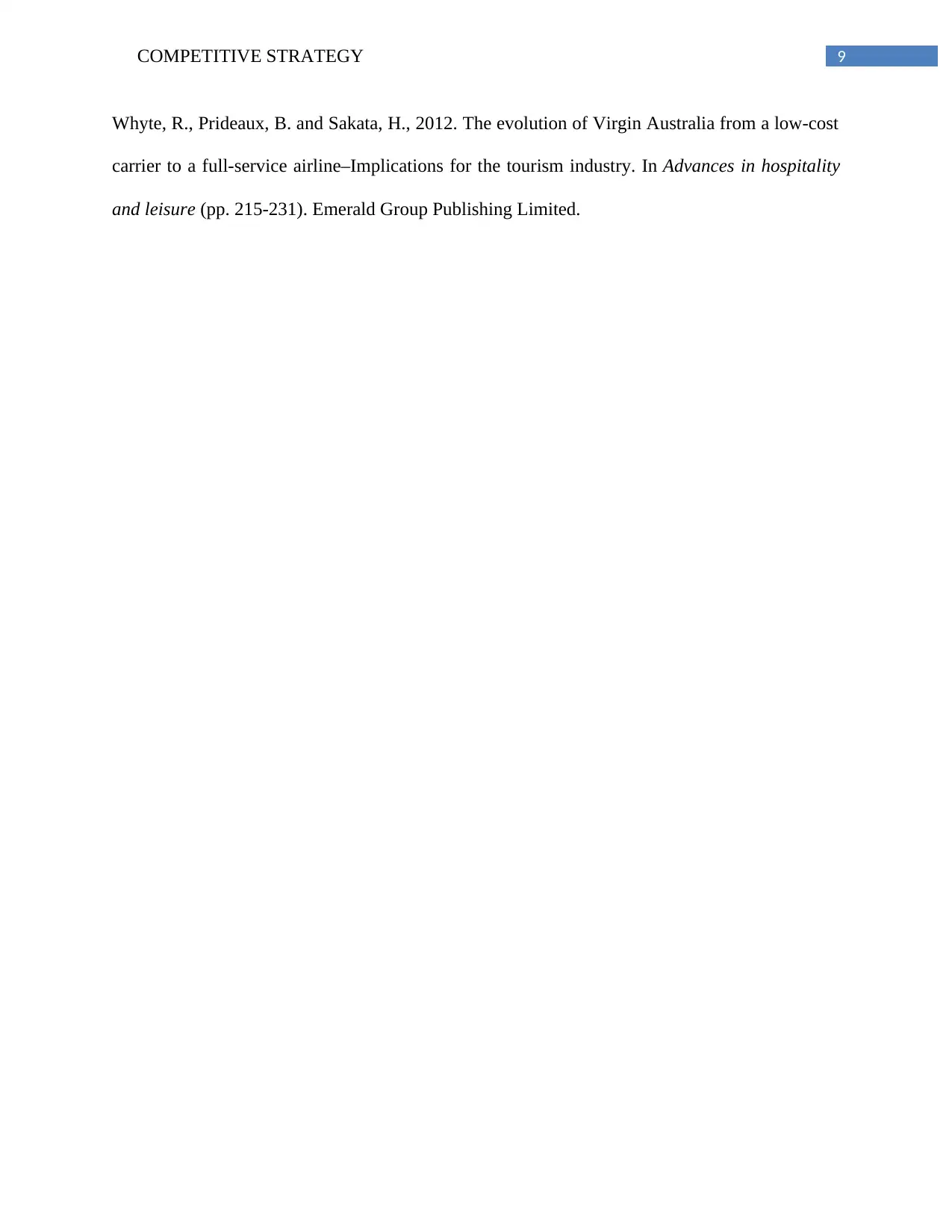
9COMPETITIVE STRATEGY
Whyte, R., Prideaux, B. and Sakata, H., 2012. The evolution of Virgin Australia from a low-cost
carrier to a full-service airline–Implications for the tourism industry. In Advances in hospitality
and leisure (pp. 215-231). Emerald Group Publishing Limited.
Whyte, R., Prideaux, B. and Sakata, H., 2012. The evolution of Virgin Australia from a low-cost
carrier to a full-service airline–Implications for the tourism industry. In Advances in hospitality
and leisure (pp. 215-231). Emerald Group Publishing Limited.
1 out of 10
Related Documents
Your All-in-One AI-Powered Toolkit for Academic Success.
+13062052269
info@desklib.com
Available 24*7 on WhatsApp / Email
![[object Object]](/_next/static/media/star-bottom.7253800d.svg)
Unlock your academic potential
Copyright © 2020–2025 A2Z Services. All Rights Reserved. Developed and managed by ZUCOL.



